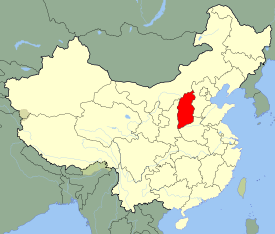Taiyuan
| Taiyuan 太原 |
|
|---|---|
| — Prefecture-level city — | |
| 太原市 | |
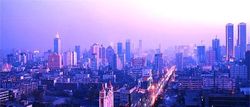 |
|
| Nickname(s): Bingzhou(并州); Jinyang(晋阳); Dragon City(龙城) | |
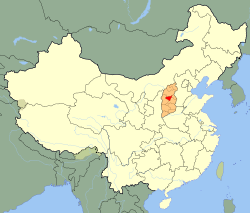 |
|
| Coordinates: | |
| Country | China |
| Province | Shanxi |
| Government | |
| - Mayor | Zhang Bingsheng (张兵生) |
| Area | |
| - Total | 6,956 km2 (2,685.7 sq mi) |
| Elevation | 800 m (2,625 ft) |
| Highest elevation | 2,670 m (8,760 ft) |
| Lowest elevation | 760 m (2,493 ft) |
| Population (2004) | |
| - Total | 3,413,800 |
| - Density | 490.8/km2 (1,271.1/sq mi) |
| Time zone | China Standard (UTC+8) |
| Area code(s) | 351 |
| GDP | ¥ 146.8 billion (2008) |
| GDP per capita | ¥ 41,319 (2008) |
| Major Nationalities | Han |
| County-level divisions | 10 |
| Township-level divisions | 83 |
| Licence Plate Prefixes | 晋A |
| Website | http://www.taiyuan.gov.cn |
| Taiyuan | |||||||||||||
|---|---|---|---|---|---|---|---|---|---|---|---|---|---|
| Chinese | 太原 | ||||||||||||
| Literal meaning | great plains | ||||||||||||
|
|||||||||||||
Taiyuan (Chinese: 太原; pinyin: Tàiyuán; Wade–Giles: T'ai-yüan; Mandarin pronunciation: [tʰaɪ̯˥˩ɥan˧˥]; lit. "Great Plains", where the Fen River leaves the mountains) is a prefecture-level city and the capital of Shanxi province, China.[1] In 2004, the city had a population of 3.4 million.
Contents |
History
Pre-1911
From around 859BC the area was held by the Rong people. In 662 they were driven out by the Beidi.
Taiyuan was an ancient capital, constructed by Zhaojianzi (趙簡子/赵简子) in ca. 500 BC, named Jinyang (晉陽/晋阳). It was renamed Taiyuan in the Qin Dynasty. Several Emperors came from this city, the most famous emperor is Li Shimin and his father Li Yuan, Emperor Gaozu, during the Tang Dynasty. Many ancient Chinese poets were also from Taiyuan. During the Tang Dynasty, Taiyuan was a secondary capital of China and a cultural center. The oldest existing building in the city is the Temple of Goddess (聖母殿/圣母殿) inside the Jin Ci Complex; it was originally built in AD 1023 and reconstructed in AD 1102. The city had been deliberately flooded several times in 453 BC, AD 969, and was also destroyed by war in AD 1125.
The city was originally the site of Jinyang, a strategic center for the ancient state of Zhao. After the Qin conquest of Zhao in 221 BC, it became the seat of the commandery (district under the control of a commander) of Taiyuan, which continued during the Han dynasty (206 BC–AD 220) and after. In the Later Han period, it became the capital of the province (zhou) of Bing.
For a time in the 6th century, the city was a secondary capital of Eastern Wei and Northern Qi states, growing into a fairly large city and also becoming a center of Buddhism. A new city was built in AD 562, which was later linked to the old city during the Tang Dynasty in AD 733. From that time until the middle of the Tang dynasty (618–907), the construction of the cave temples at Tianlong Mountain just southwest of the city, continued. The dynastic founder of the Tang began his conquest of the empire with Taiyuan as a base and using the support of its local aristocracy. It was periodically designated as the Tang's northern capital and grew into a heavily fortified military base.
The old city was at Taiyuanzhen, a few miles east of the modern city. After the Song conquest in 960, Emperor Taizong of Song ordered to destroy it, and a new city was set up on the banks of the Fen River in 982.[2] The city became a superior prefecture in 1059 and administrative capital of Hedong (northern Shanxi) in 1107. It retained this function, with various changes in its name and status, down to the end of the Mongol period (1368). At the beginning of the Ming dynasty (1368–1644), it was renamed Taiyuan Fu (府, fu, meaning "chief town") and retained this name until 1912. During Ming Dynasty, the city wall was reconstructed in AD 1568. Under the Ming dynasty and in the Qing period (1644–1911), it was capital of Shanxi. Under the republic (established in 1911), its name was changed to Yangqu, a name it retained until 1947.
In 1900, during the Boxer Rebellion, seventy-seven unarmed Western missionaries were executed in front of the provincial governor. This incident became known as the Taiyuan Massacre.
In 1907 the importance of Taiyuan was increased by the construction of a rail link to Shijiazhuang, in Hebei, on the Beijing to Wuhan trunk line. Soon thereafter Taiyuan suffered a serious economic crisis. In the 19th century the merchants and local banks of Shanxi had been of national importance, but the rise of modern banks led to the rapid decline of this system — with disastrous effects upon Shanxi and its capital.
1911–1949
After 1911, Shanxi remained under control by warlord Yen Hsi-shan who retained control of the area from 1913 to 1948. Taiyuan consequently flourished as the center of his comparatively progressive province and experienced extensive industrial development. It was also linked by rail both to the far southwest of Shanxi and to Datong in the north.
After the Japanese invasion in 1937, Taiyuan's industries continued to develop further. In 1945 the Japanese army in Shanxi surrendered to Yen Xi-shan and continued to fight for him until 1948. Eventually, the Chinese communist armies captured Taiyuan.
1949–present
Since 1949, Taiyuan has developed a large industrial base with heavy industry (notably iron and steel) of prime importance; local coal production is considerable. Taiyuan is also an engineering center, as it produces cement, and has a large chemical-industrial complex. It is also a center of education and research, particularly in technology and applied science.
Geography
| Taiyuan | ||||||||||||||||||||||||||||||||||||||||||||||||||||||||||||
|---|---|---|---|---|---|---|---|---|---|---|---|---|---|---|---|---|---|---|---|---|---|---|---|---|---|---|---|---|---|---|---|---|---|---|---|---|---|---|---|---|---|---|---|---|---|---|---|---|---|---|---|---|---|---|---|---|---|---|---|---|
| Climate chart () | ||||||||||||||||||||||||||||||||||||||||||||||||||||||||||||
|
||||||||||||||||||||||||||||||||||||||||||||||||||||||||||||
|
||||||||||||||||||||||||||||||||||||||||||||||||||||||||||||
Taiyuan is one of the great industrial cities of China and lies on the Fen River in the north of its fertile upper basin. It commands the north-south route through Shanxi, as well as important natural lines of communication through the mountains to Hebei province in the east and (via Fenyang) to northern Shanxi province in the west. It is considered to be one of the world's most polluted cities, although factory shutdowns related to global economic downturn may have reduced environmental hazards somewhat.[4]
Climate
Taiyuan experiences a semi-arid climate (Köppen climate classification BSk). Spring is dry, with frequent dust storms, followed by early summer heat waves. Summer tends to be warm to hot with most of the year's rainfall concentrated in July and August. Winter is long and cold, but dry and sunny. Because of the aridity, there tends be considerable diurnal variation in temperature, except during the summer.
| Climate data for Taiyuan (1971–2000) | |||||||||||||
|---|---|---|---|---|---|---|---|---|---|---|---|---|---|
| Month | Jan | Feb | Mar | Apr | May | Jun | Jul | Aug | Sep | Oct | Nov | Dec | Year |
| Average high °C (°F) | 1.8 (35.2) |
5.4 (41.7) |
11.5 (52.7) |
19.8 (67.6) |
25.5 (77.9) |
28.6 (83.5) |
29.3 (84.7) |
28.0 (82.4) |
23.7 (74.7) |
17.8 (64) |
9.5 (49.1) |
3.1 (37.6) |
17.0 (62.6) |
| Average low °C (°F) | −11.6 (11.1) |
−8.0 (18) |
−2.0 (28) |
4.8 (40.6) |
10.5 (50.9) |
15.1 (59.2) |
18.2 (64.8) |
16.9 (62.4) |
10.8 (51.4) |
4.0 (39.2) |
−2.7 (27.1) |
−9.2 (15.4) |
3.9 (39) |
| Precipitation mm (inches) | 3.2 (0.126) |
5.2 (0.205) |
13.4 (0.528) |
19.9 (0.783) |
33.3 (1.311) |
55.9 (2.201) |
102.1 (4.02) |
107.0 (4.213) |
51.6 (2.031) |
25.6 (1.008) |
10.7 (0.421) |
3.2 (0.126) |
431.2 (16.976) |
| % Humidity | 50 | 47 | 50 | 47 | 50 | 60 | 73 | 77 | 73 | 67 | 62 | 56 | 59.3 |
| Avg. precipitation days | 1.9 | 2.9 | 4.4 | 4.3 | 5.7 | 9.3 | 12.4 | 11.2 | 8.1 | 5.4 | 3.3 | 1.4 | 70.3 |
| Sunshine hours | 173.4 | 174.0 | 202.3 | 229.8 | 265.1 | 250.9 | 228.6 | 223.8 | 209.6 | 206.9 | 174.6 | 162.6 | 2,501.7 |
| Source: China Meteorological Administration [3] | |||||||||||||
Administrative divisions
- Xinghualing District 杏花岭区
- Xiaodian District 小店区
- Yingze District 迎泽区
- Jiancaoping District 尖草坪区
- Wanbailin District 万柏林区
- Jinyuan District 晋源区
- Gujiao City 古交市
- Qingxu County 清徐县
- Yangqu County 阳曲县
- Loufan County 娄烦县
Economy
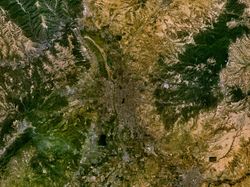
In 2008, Taiyuan's nominal GDP was 146.8 billion yuan, a growth of 8.1% from the previous year. Taiyuan's primary, secondary, and tertiary industries were worth 2 billion yuan, 63.9 billion yuan, and 59.6 billion yuan respectively in 2007. Taiyuan is the largest coal mining center in China. It also houses several large corporations in Taiyuan, such as the Taiyuan Iron and Steel Company (TISCO) which is the largest stainless steel producing plant in Asia. Also, the Shanxi Heavy Machinery Factory and Fenxi Machinery Factory are major manufacturers for the People's Liberation Army and Navy, producing submarine missiles for them. The largest local bank of Taiyuan is ICBC( Industrial and Commercial Bank of China).
Residential Area
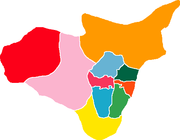
The most populated area in Taiyuan is Yinze District which is the downtown of Taiyuan City. Wanbailing and Xinhualing Districts are the other major residential districts. Apartments in high rises are the most common residence for the civics. Rare houses occupied by the government officials can be found along part of the Fen River and the suburbs except the northern area of the city for the high density of heavy industry in the north. The city's most expensive housing area currently is the part of Beidajie Avenue between Fen River and Wuyi Road for the CBD (Central Business District) of the metropolis is being built along the street. The Taiyuan area's most luxurious hotels and restaurants have been built along the avenue with some shopping malls and huge supermarkets surrounding. The City Revenue Agency, the City Procurator Fiscal, City Hall, and several telecommunication companies, such as China Telecom and China Mobile are located along the avenue. The housing price has reached 20000 RMB/m, roughly equal to $300/ft.
Transportation
Inner City transportation The Fen River flows through the city from north to south, dividing the city into two parts: Qiaoxi (West of the Bridge) and Qiaodong (East of the Bridge). As of 2007, there are five bridges across the Fen River within the city limits: the Shengli Bridge (1970), the Yifen Bridge (1990), the Yingze Bridge (1954), the Nanneihuan Bridge (1988), and the Changfeng Bridge (2001). About ten kilometers to the north of the Shengli Bridge, there is the Chaicun Bridge. Two more bridges are being planned: Beizhonghuan Bridge and Nanzhonghuan Bridge.
Air The primary airport of the city is Taiyuan Wusu Airport. The airport has been expanded for the landing of Airbus A380.
Highway
- A highway circling the metropolis of City of Taiyuan has been built.
- China National Highway 208
Railway The newly constructed high-speed railway has shortened the transitting time between Taiyuan and Beijing to less than three hours on a distance of 600 km.
Food
Taiyuan's local specialties include:
- Wheat-made Food: Liang Fen (see Grass jelly), Mian Pi (面皮)
- Noodles: Dalu Mian, Dao Xiao Mian (刀削面, Knife-Cut Noodles), Lamian, Mao Er Duo (猫耳朵, Cat Ear Noodle), Xi Hong Shi Chao Ji Dan Mian (西红柿炒鸡蛋面), Noodles with Tomato and Scrambled Eggs), Ti Mian (剔面, Scraped Noodles)
- Soup:
- Tou Nao (头脑, "Brain" Soup): Contains mutton, rice wine and vegetables in the soup. It was invented by a famous person named FuShan. He invented it for his mother.)
- Yang Za Ge,Yang Rou tang (羊肉汤): a kind of soup which is made of mutton. Served during the wintertime
- Wan Zi Tang (丸子汤): meatball soup
- Vinegar: Taiyuan is known for its vinegar, Lao Chen Cu (老陈醋, "Long-preserved Vinegar").
Tourism
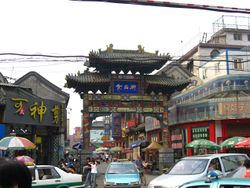
Several tourist attractions in and around Taiyuan include the Liu Xiang Lane, which contains ancient Chinese houses of important heritage, and several temples, such as the Chongshan Monastery, the Jinci Temple, the Twin Pagoda Temple, and the Shaunglin Monastery Longtan Park and Yinze Park are also popular tourist destinations.[5]
Taiyuan is also known for its Liuxiang shopping district and the construction of parks and recreational areas that are praised by the UN Environmental Programme for their role in the improvement of the environmental condition of Taiyuan. Taiyuan's environmental improvement project is being copied in many other Chinese cities and urban areas around the world.
Education
Major schools
- Taiyuan No.5 Middle School (太原第五中学)
- Shanxi Experimental Secondary School (山西省实验中学)
- Taiyuan Foreign Language School (太原外国语学校)
- Taiyuan Chengcheng Middle School (太原成成中学)
Colleges and universities
- Shanxi Agricultural University (山西农业大学)
- Shanxi College of Traditional Chinese Medicine (山西中医学院)
- Shanxi Medical University (山西医科大学)
- Shanxi Teachers University also called Shanxi Normal University (山西师范大学)
- Shanxi University (山西大学)
- Shanxi University of Finance and Economics (山西财经大学)
- Taiyuan Normal University (太原师范学院)
- Taiyuan University of Science and Technology (太原科技大学)
- Taiyuan University of Technology (太原理工大学)
- North University of China (中北大学)
See also
- Taiyuan Satellite Launch Center is one of China's few stations for rocket launch.
International relations
Twin towns — Sister cities
Taiyuan is twinned with:
 – Chemnitz (Germany)
– Chemnitz (Germany) – Himeji (Hyōgo, Japan)
– Himeji (Hyōgo, Japan) – Launceston, Tasmania, Australia
– Launceston, Tasmania, Australia – Nashville (Tennessee, United States)
– Nashville (Tennessee, United States) – Newcastle upon Tyne, United Kingdom
– Newcastle upon Tyne, United Kingdom – Syktyvkar, Russia
– Syktyvkar, Russia – Saratov, Russia
– Saratov, Russia
References
- ↑ Taiyuan Travel Guide: City Map, History
- ↑ 宋太宗平毁太原 盗墓史上那些挖别人祖坟的事(4)
- ↑ 3.0 3.1 "China Meteorological Data Sharing Service System" (in Simplified Chinese). China Meteorological Administration. http://cdc.cma.gov.cn/shuju/index3.jsp?tpcat=SURF&dsid=SURF_CLI_CHN_MUL_MMON_19712000_CES&pageid=3. Retrieved 2009-03-17.
- ↑ [1]
- ↑ Taiyuan Attractions
External links
|
|||||||||||||||
|
||||||||||||||||||||||
|
|||||
|
|||||||
